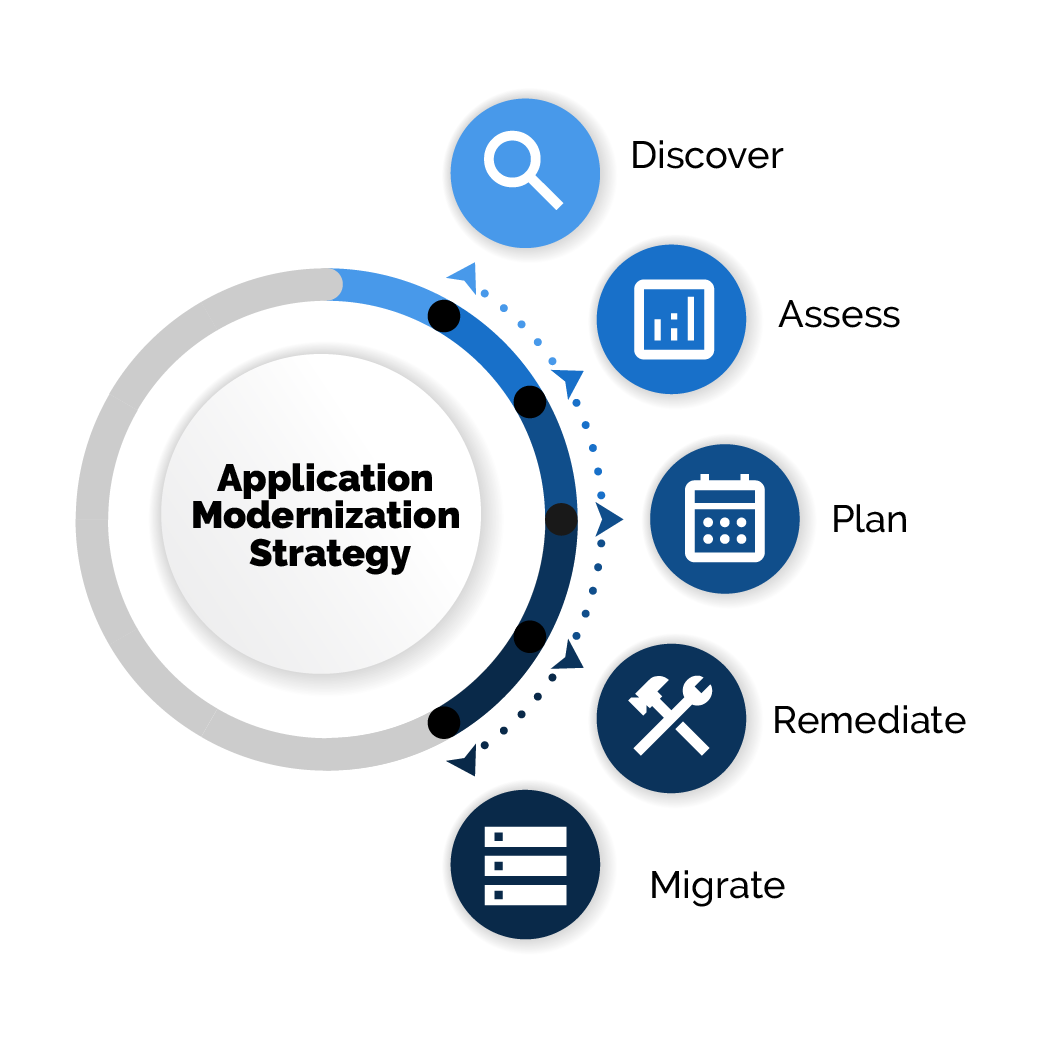Application Modernization Strategy Basics

What is an Application Modernization Strategy?
An application modernization strategy is a uniquely formulated plan designed to help you execute your application modernization. Also known as legacy or software modernization, application modernization is converting, rewriting, or porting a legacy system to modern computer programming languages, architectures, software libraries, protocols, or hardware platforms. When executed with a holistic application modernization strategy, this helps extend the application's value through migration to new platforms, which brings the benefits of the latest technology with them.
When Coretek develops an application modernization strategy, we do so under the assumption we will be using Microsoft Azure. Azure enables businesses to reduce and control costs, improve agility in application performance, enable continuous delivery, enhance app development with DevOps, and simplify support of applications.
Which Businesses Should Consider Application Modernization?
Many businesses can benefit from modernizing their applications. At the rate technology advances, it is vital to your business's success to plan a technology roadmap for the future. If you're stuck with legacy technology, scaling to meet the demands of your customers can be challenging. However, application modernization benefits some businesses more than others based on your industry and overall business goals. Below are the types of organizations that tend to reap the most significant rewards from modernizing applications in the cloud.
SaaS Companies
SaaS companies are organizations that use software to provide customers with a service. These businesses create, develop, host, and update their products in-house. And many SaaS companies require the support of an entire in-house development team to keep their product or service on a predictable and constantly moving application lifecycle. Therefore, application modernization is essential to the long-term success of companies like these. They must be able to scale quickly to meet the demands of their customer base and plan for the future without worrying about the capital cost of new technology. In addition, they get the benefits of a more stable application and a reduction of ongoing support costs.
Companies with In-House Development Teams
"All companies are software companies. Every company is a software company. You have to start thinking and operating like a digital company,"
—Satya Nadella, CEO of Microsoft.
Some businesses are not SaaS companies at their core. Still, to keep delivering value to their customer base or compete in a market where customers require access to mobile apps, they hire a team of developers to build and maintain their applications. These businesses include automotive companies competing in the electric vehicle space, retail and grocery chains that develop B2C mobile shopping and ordering apps, utility providers offering a customer login for payment and account management, and some healthcare organizations looking to modernize their patient care.
The 5-Part Application Modernization Strategy
1. Discover Your Application or Database
The first step is to understand what your business is trying to accomplish. What business value does the organization need to achieve with modernization, and how can those be integrated? We seek to define the outcomes required for:
- Overall business value
- Financial
- Scalability
- Quality
- Consistency
Based on the complexity and dependencies of the outcomes needed, Coretek will utilize either traditional Platform as a Service(PaaS) versus a combination of PaaS and containerization. Containerization is a container consisting of an entire runtime environment: An application, plus all its dependencies, libraries, other binaries, and configuration files needed to run it, bundled into one package. By containerizing the application platform and its dependencies, it eliminates differences in operating systems, distributions, and underlying infrastructure. Containerization matters because it provides the ability to deploy a consistent application across environments and ensure quality releases and release management every time.
2. Compose the Assessment
Our team uses a unique tool called UnifyCloud in conjunction with the Microsoft Solution Assessment Team to provide an App Innovation Assessment or App Mod Assessment. First, we import the application source code into UnifyCloud and assess the compatibility with different PaaS services or containerization, such as Kubernetes. Next, we identify compatibility issues and the exact location of the problems within the source code.
3. Build a Migration Plan
The migration plan consists of the work effort for remediation and the project's cost expectations, including services and cloud cost consumption (TCO). The plan evaluates these against the expected outcomes to ensure a successful ROI.
4. Remediation
Remediation includes the assessment findings and building the containers to deploy to the cloud; in our case, we use Microsoft Azure.
5. Migration Time!
During migration, everything is deployed as code through pipelines. We typically use Terraform but can use ARM depending on the project's needs.

Don’t Over-Complicate App Modernization
This five-step strategy is our proven approach to application modernization. Even though it sounds complicated, application modernization doesn't need to be as complex as you think. The complication comes when forcing unnecessary remediation into a project. Performing remediation is essential, but only when it helps achieve business objectives.
Defining and meeting the business needs and goals for the project is the most critical aspect of any app modernization project. Do that, and your project is off to a great start.
Want to learn more about application modernization strategy? Check out our eBook!

 Smart Cloud
Smart Cloud
 Smart Workspace
Smart Workspace
 Managed Services
Managed Services